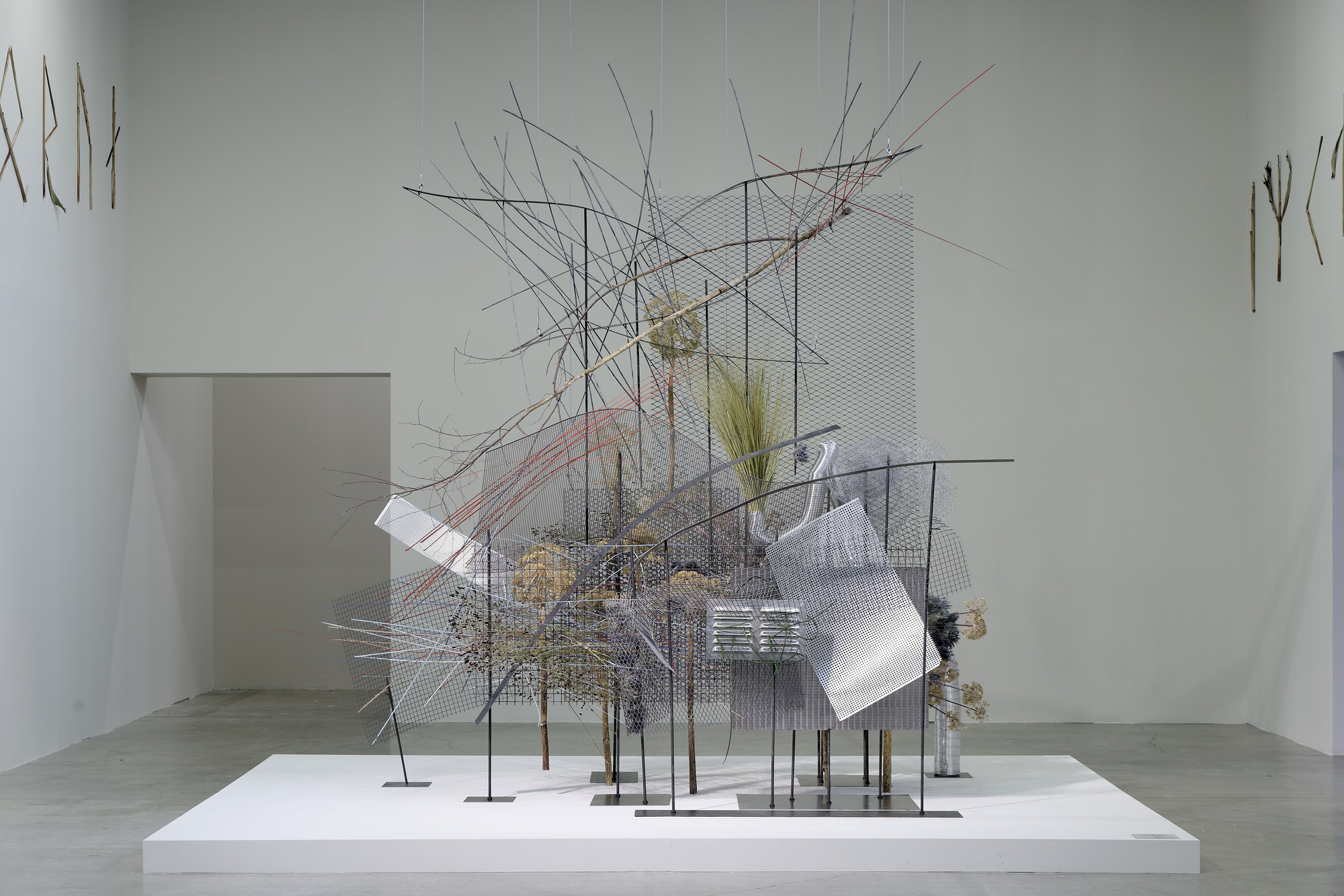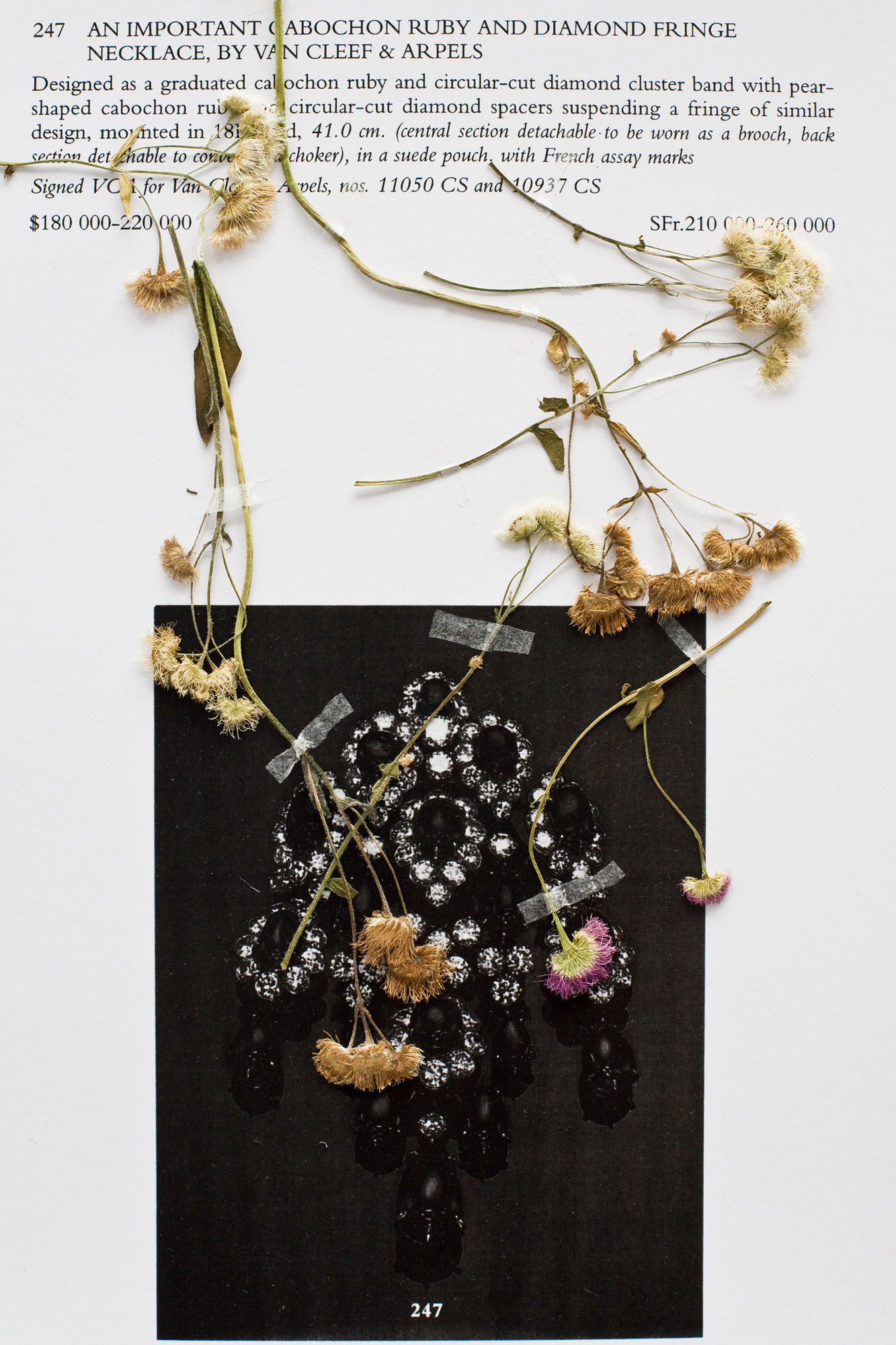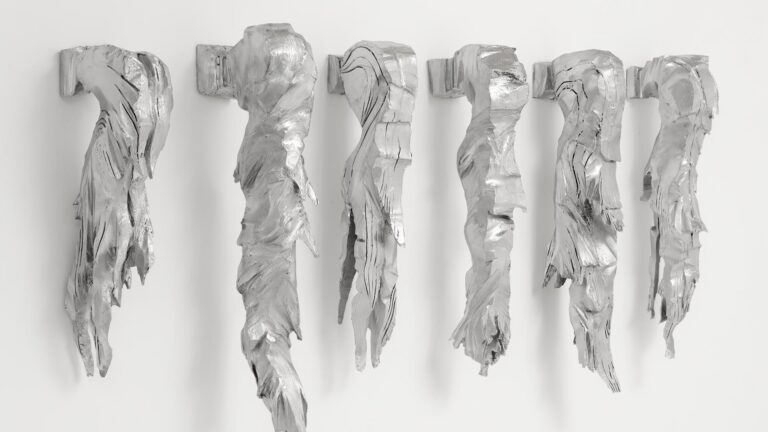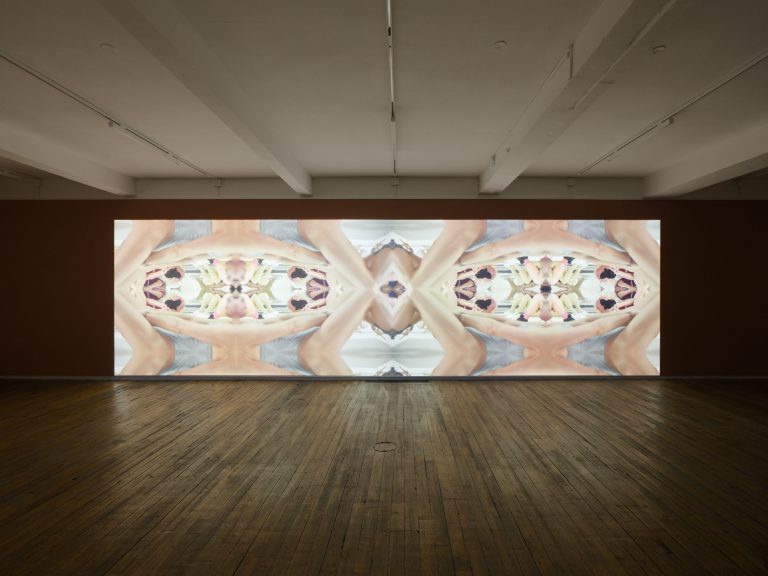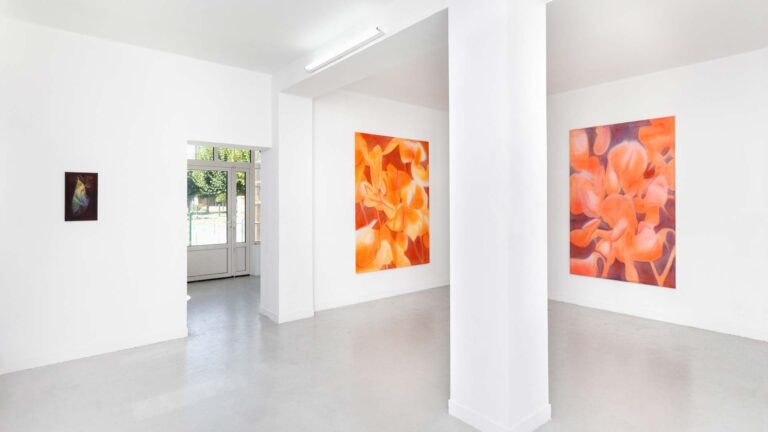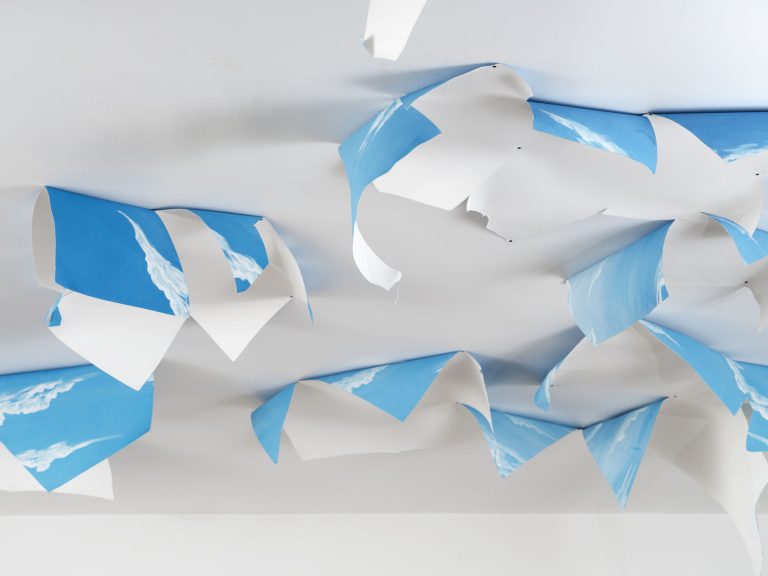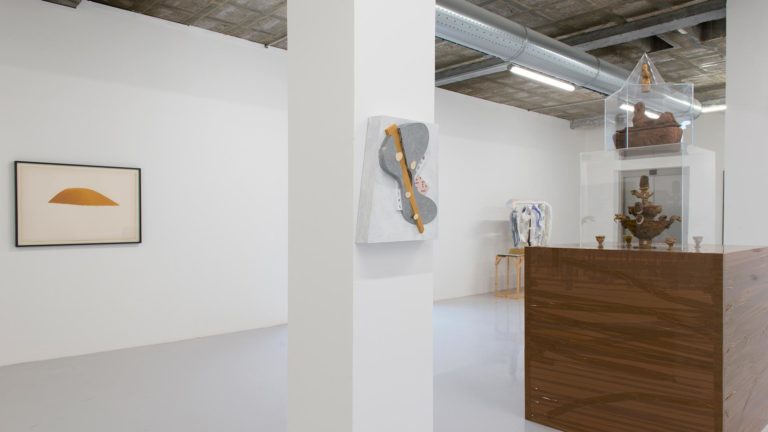Artist: Camille Henrot
Artists invited by Camille Henrot: Jacob Bromberg, David Horvitz, Maria Loboda, Nancy Lupo, Samara Scott, Avery Singer
Exhibition title: Days are Dogs
Curated by: Daria de Beauvais
Venue: Palais de Tokyo, Paris, France
Date: October 18, 2017 – January 7, 2018
Photography: all images copyright and courtesy of the artist, ©Palais de Tokyo and the respective copyright holders
Palais de Tokyo is giving its entire exhibition space to Camille Henrot (born in Paris in 1978, lives in New York) for the third installment of its series of cartes blanches exhibitions, which began in 2013 with Philippe Parreno and continued in 2016 with Tino Sehgal. The carte blanche offered to Henrot — winner of the Silver Lion at the 55th Venice Biennale (2013) as well as the Nam June Paik Award (2014) and the Edward Munch Award (2015) — will be an occasion to discover the everexpanding fields of inquiry that influence her idiosyncratic sculptures, drawings, video and installations.
Titled “Days are Dogs”, Henrot’s exhibition questions the relationships of authority and fiction that determine our existence, and is organized around one of the most foundational structures in our lives – the week.
Years are measured by the journey of the Earth around the Sun; months derive from the position of the Moon; days correspond to a rotation of the Earth. The week, by contrast, is a fiction, a human invention. Yet that does not diminish its emotional and psychological effects. We experience it as a narrative cycle, structured by the particular qualities of its component days.
Each room of the exhibition evokes a day of the week – an open world where conventions, emotions, and individual freedom are playfully confronted with one another.
Our days take their names from the cosmos and mythology – the Moon for Monday, the god Thor for Thursday, the god Saturn for Saturday – and the viewer is invited into a new human mythology, both contemporary and timeless: a mythology from the Internet age, where emotions are marked by each day’s hashtag.
The exhibition as a whole operates through the composition and recomposition of archipelagoes of artworks – works by Camille Henrot herself, some of them presented for the first time, as well as those by international artists, broadening the scope of each day.
Curator: Daria de Beauvais
“Carte Blanche” To Camille Henrot
“With “Days are Dogs”, I look to explore the concept of the week as a human invention (in contrast to solar days and years or lunar months) that has colonized the entire globe’s conception of time, imposing a standard that is mobilized in the interests of productivity. It is a construct that both fortifies and alienates us. As a repetitive unit of time, the week is both reassuring in its predictability and disquieting in its creation of obligations – it is completely arbitrary and yet totally valid. It’s a story we’re told, like the stories we tell to children. We, as human beings, love to give ourselves over to a system we cherish because it is familiar. At the same time, this submission gives rise to the perversity of dependency – the desire to be constrained.
A system can only ever be replaced by another system. I am interested in the over-application of a system’s rules to free oneself from the very rules by which that system operates, thereby enabling subjective, personal logics to thrive. As any structuring of time is a structuring of obligations, needs, and desires, I use the banal, semi-unconscious construct of the week to draw connections between intimate logics and large societal problems: a flower becomes a reflection on compensation and on gender and class inequalities (Jewels from the Personal Collection of Princess Salimah Aga Khan), a crinkling candy wrapper expresses a nameless worry as it opens (Is He Cheating?). To cite Roland Barthes, “it is when something ‘goes without saying’ that it needs to be looked at closely – and it then emerges that ‘what goes without saying’ is in fact comprised of a number of unanswered questions.”[1]
By using the temporal structure of the week, this exhibition seeks to defamiliarize many of the obligations we have grown so accustomed to as to consider natural. While the arbitrary yet manifold significations of each day provide us with external structure, a shared field of meanings coming from mythology, and thus allow us to detach ourselves from the problems of making decisions regarding what to do with our days, with our lives, the rhythm of the week imposes obligations on us: to go out for drinks, to consume culture, to sleep, etc. We are constantly assaulted by contradictory directives to obey our desires and obligations as friends, as parents, as dog owners, runners, smokers, citizens, empathetic humans, and lovers, not to mention the caterwauling agglomeration of desires addressed to us by the digital sphere. As such, my “carte blanche” is a meditation on dependency and freedom, on how to live with compromise and alterations to our ideals and yet to maintain our idealism and hope for change .“
-Camille Henrot
[1] R. Barthes, How To Live Together: Novelistic Simulations of Some Everyday Spaces, Colombia University Press, 2013
Days Are Dogs: Saturday
“The authentic (das Eigentliche) in man and in the world is potential, waiting, living in fear of being frustrated, living in hope of succeeding.”
Ernst Bloch, The Principle of Hope
Anything is possible on Saturday; or so we hope on this day, set under the sign of Saturn (Chronos in Greek mythology, god of time, generation, dissolution, and life cycles).
Camille Henrot’s latest film, Saturday, focuses on the Seventh-Day Adventist (SDA) Church, an evangelical Christian denomination with an apocalyptic expectation, that celebrates the Sabbath and practices immersion baptism rituals on Saturday. Through the figure of the SDA Church appear the themes of hope for a better life and the desire to flee the daily mundane, which here manifests in a religious mode, but takes form elsewhere in the practice of particular dietary rules and extreme sports.
Shot mostly in 3D, the film combines scenes recorded at SDA Church sites in the USA, Polynesia, and the Kingdom of Tonga with images of food, surfing, and medical tests; together, they immerse us in a parallel world of hope and belief – of transparencies and opacities. Meanwhile, text scrolling at the bottom of the screen materializes both a source of information and a desire to escape from it.
Seven paintings by Avery Singer (b. 1987, USA) corresponding to each day of the week act as the frontispiece for the exhibition.
Avery Singer, Days of the Weak series, 2017, acrylic on canvas stretched over wood panel, Courtesy of the artist, Gavin Brown’s enterprise (New York) and Kraupa-Tuskany Zeidler (Berlin), Exhibition view of “Days are Dogs”, Carte Blanche to Camille Henrot, Palais de Tokyo (18.10.2017 – 07.01.2018), Photo: Aurélien Mole
Avery Singer, Days of the Weak series, 2017, acrylic on canvas stretched over wood panel, Courtesy of the artist, Gavin Brown’s enterprise (New York) and Kraupa-Tuskany Zeidler (Berlin), Exhibition view of “Days are Dogs”, Carte Blanche to Camille Henrot, Palais de Tokyo (18.10.2017 – 07.01.2018), Photo: Aurélien Mole
Exhibition view of “Days are Dogs”, Carte Blanche to Camille Henrot, Palais de Tokyo (18.10.2017 – 07.01.2018), Courtesy of the artist and kamel mennour (Paris/London); König Galerie (Berlin); Metro Pictures (New York) © ADAGP, Paris 2017, Photo: Aurélien Mole
Exhibition view of “Days are Dogs”, Carte Blanche to Camille Henrot, Palais de Tokyo (18.10.2017 – 07.01.2018), Courtesy of the artist and kamel mennour (Paris/London); König Galerie (Berlin); Metro Pictures (New York) © ADAGP, Paris 2017, Photo: Aurélien Mole
Camille Henrot, Saturday, 2017, film still, courtesy of the artist; kamel mennour (Paris/London); König Galerie (Berlin); Metro Pictures (New York). © ADAGP, Paris 2017
Camille Henrot, Saturday, 2017, film still, courtesy of the artist; kamel mennour (Paris/London); König Galerie (Berlin); Metro Pictures (New York). © ADAGP, Paris 2017
Camille Henrot, Saturday, 2017, film still, courtesy of the artist; kamel mennour (Paris/London); König Galerie (Berlin); Metro Pictures (New York). © ADAGP, Paris 2017
Camille Henrot, Saturday, 2017, film still, courtesy of the artist; kamel mennour (Paris/London); König Galerie (Berlin); Metro Pictures (New York). © ADAGP, Paris 2017
Camille Henrot, Saturday, 2017, film still, courtesy of the artist; kamel mennour (Paris/London); König Galerie (Berlin); Metro Pictures (New York). © ADAGP, Paris 2017
Camille Henrot, Saturday, 2017, film still, courtesy of the artist; kamel mennour (Paris/London); König Galerie (Berlin); Metro Pictures (New York). © ADAGP, Paris 2017
Camille Henrot, Saturday, 2017, film still, courtesy of the artist; kamel mennour (Paris/London); König Galerie (Berlin); Metro Pictures (New York). © ADAGP, Paris 2017
Camille Henrot, Saturday, 2017, film still, courtesy of the artist; kamel mennour (Paris/London); König Galerie (Berlin); Metro Pictures (New York). © ADAGP, Paris 2017
Days Are Dogs: Sunday
“Our rulers at the present day, with their machines and their preachers, are all occupied in putting into our heads the preposterous notion that activity rather than contemplation is the object of life.”
– John Cowper Powys, In Defence of Sensuality
Named after the Sun, Sunday is also the day for sleeping in, cleaning house, spiritual connection, and solitary daydreams. It is a day outside of society, spent at home.
Camille Henrot adapts ikebana – traditional Japanese flower arrangements created according to specific codes – using a heterodox method, transforming them into conversations with literature, as each arrangement is conceived in dialogue with a book from the artist’s library. These ikebana bring the world of Sunday to light, gesturing to reading time, solitude, and one’s relationship to oneself. They question other salient themes, such as the belonging to an order (that of the ikebana, but also the social and political order more generally) and the break from this order, as well as the confrontation of the pleasure principle with the principle of productivity, with ideology.
The private space is at the heart of the installation The Pale Fox, where personal material is accumulated and superimposed according to an excess of principles (the cardinal directions, the stages of life, Leibniz’s philosophical principles), creating the physical experience of a sleepless night when everything is put on the line. Sunday is the moment when the world’s intimate sequencing reflects the breadth of the universe.
Exhibition view of “Days are Dogs”, Carte Blanche to Camille Henrot, Palais de Tokyo (18.10.2017 – 07.01.2018), Courtesy of the artist and kamel mennour (Paris/London); König Galerie (Berlin); Metro Pictures (New York) © ADAGP, Paris 2017, Photo: Aurélien Mole
Exhibition view of “Days are Dogs”, Carte Blanche to Camille Henrot, Palais de Tokyo (18.10.2017 – 07.01.2018), Courtesy of the artist and kamel mennour (Paris/London); König Galerie (Berlin); Metro Pictures (New York) © ADAGP, Paris 2017, Photo: Aurélien Mole
Exhibition view of “Days are Dogs”, Carte Blanche to Camille Henrot, Palais de Tokyo (18.10.2017 – 07.01.2018), Courtesy of the artist and kamel mennour (Paris/London); König Galerie (Berlin); Metro Pictures (New York) © ADAGP, Paris 2017, Photo: Aurélien Mole
Exhibition view of “Days are Dogs”, Carte Blanche to Camille Henrot, Palais de Tokyo (18.10.2017 – 07.01.2018), Courtesy of the artist and kamel mennour (Paris/London); König Galerie (Berlin); Metro Pictures (New York) © ADAGP, Paris 2017, Photo: Aurélien Mole
Exhibition view of “Days are Dogs”, Carte Blanche to Camille Henrot, Palais de Tokyo (18.10.2017 – 07.01.2018), Courtesy of the artist and kamel mennour (Paris/London); König Galerie (Berlin); Metro Pictures (New York) © ADAGP, Paris 2017, Photo: Aurélien Mole
Days Are Dogs: Monday
“— But Saturday and Sunday being free days some boys might be inclined to think that Monday is a free day also. Beware of making that mistake. I think you, Lawless, are likely to make that mistake.
— I, sir? Why, sir?”
James Joyce, A Portrait of the Artist as a Young Man
Monday is the day of the Moon: the ever-changing satellite that embodies the fluid variations of the world in ancient myth, just as it does the humors (“lunatic” comes from the Latin luna for Moon)…
David Horvitz (b. 1983, USA) traces the proliferation of a personal image of depression – an emotion that swallows one up – as it is itself engulfed by the Internet.
But in everyday life, Monday is also the beginning of the week – the return to work and the melancholy it induces. It is a day one would rather spend at home, outside of the world in a meditative, creative space, where, like Proust or Matisse, one could create from one’s bed. These two concomitant aspects – the one metaphysical and mythical, the other social and personal – are associated here to shape the world of Monday as an artist’s studio. This space – a sort of artist’s “maison absolue” [absolute house], as Henrot describes it – is a twilight zone between dreaming and wakefulness that blurs the distinctions between idleness and productivity, the mundane and the transformative, the trivial and the monumental.
Inspired in part by the poem “Drunk Too Soon”, written by 8th and 9th century Tang dynasty author Yuan Zhen, the figure of the inexhaustible Drinking Bird leans over a saucer made to look like the full Moon in order to sip whiskey.
David Horvitz, The Distance of a Day, 2013, digital video on 2 iPhones, Courtesy of the artist and ChertLüdde (Berlin), Exhibition view of “Days are Dogs”, Carte Blanche to Camille Henrot, Palais de Tokyo (18.10.2017 – 07.01.2018), Photo: Aurélien Mole
David Horvitz, At Night They Leave Their Century, 2017, wallpaper, Courtesy of the artist and ChertLüdde (Berlin), Exhibition view of “Days are Dogs”, Carte Blanche to Camille Henrot, Palais de Tokyo (18.10.2017 – 07.01.2018), Photo: Aurélien Mole
Exhibition view of “Days are Dogs”, Carte Blanche to Camille Henrot, Palais de Tokyo (18.10.2017 – 07.01.2018), Courtesy of the artist and kamel mennour (Paris/London); König Galerie (Berlin); Metro Pictures (New York) © ADAGP, Paris 2017, Photo: Aurélien Mole
Exhibition view of “Days are Dogs”, Carte Blanche to Camille Henrot, Palais de Tokyo (18.10.2017 – 07.01.2018), Courtesy of the artist and kamel mennour (Paris/London); König Galerie (Berlin); Metro Pictures (New York) © ADAGP, Paris 2017, Photo: Aurélien Mole
Exhibition view of “Days are Dogs”, Carte Blanche to Camille Henrot, Palais de Tokyo (18.10.2017 – 07.01.2018), Courtesy of the artist and kamel mennour (Paris/London); König Galerie (Berlin); Metro Pictures (New York) © ADAGP, Paris 2017, Photo: Aurélien Mole
Exhibition view of “Days are Dogs”, Carte Blanche to Camille Henrot, Palais de Tokyo (18.10.2017 – 07.01.2018), Courtesy of the artist and kamel mennour (Paris/London); König Galerie (Berlin); Metro Pictures (New York) © ADAGP, Paris 2017, Photo: Aurélien Mole
Exhibition view of “Days are Dogs”, Carte Blanche to Camille Henrot, Palais de Tokyo (18.10.2017 – 07.01.2018), Courtesy of the artist and kamel mennour (Paris/London); König Galerie (Berlin); Metro Pictures (New York) © ADAGP, Paris 2017, Photo: Aurélien Mole
Exhibition view of “Days are Dogs”, Carte Blanche to Camille Henrot, Palais de Tokyo (18.10.2017 – 07.01.2018), Courtesy of the artist and kamel mennour (Paris/London); König Galerie (Berlin); Metro Pictures (New York) © ADAGP, Paris 2017, Photo: Aurélien Mole
Days Are Dogs: Tuesday
“The element of contempt in the submission of the masochist has often been emphasized: his apparent obedience conceals a criticism and a provocation. He simply attacks the law on another flank.”
– Gilles Deleuze, Masochism: Coldness and Cruelty
Tuesday is ardently oppositional, competitive and warlike. The uniform grid of the jiu-jitsu mat warns us that we stand in an arena where space itself is an object of control and struggle. The sculpture Tug of War simultaneously evokes the pain of having one’s hair braided and the pleasure of being cared for. Here, we find a key element in power relationships: masochism, and the temporary and fictitious inversion of power dynamics with which it is associated.
In the film Tuesday, caretaking for thoroughbreds evokes both sexual drives and preparations for war – two forms of competition and potential exploitation. The use of slow motion in the film and of chains to anchor the sculptures effects a suspension of power relationships in an indeterminate space. This central element of the masochist’s strategy consists in slowing or arresting manifestations of strength to the point where they become aesthetic activities, and thus sensual objects of contemplation.
In the stairwell, Samara Scott (b. 1985, UK) has created a sedimented assemblage where the remainders of the preceding day accumulate alongside portents of the next.
Samara Scott, Grounds, 2017, mixed media, Courtesy of the artist and The Sunday Painter (London), Exhibition view of “Days are Dogs”, Carte Blanche to Camille Henrot, Palais de Tokyo (18.10.2017 – 07.01.2018), Photo: Aurélien Mole
Samara Scott, Grounds, 2017, mixed media, Courtesy of the artist and The Sunday Painter (London), Exhibition view of “Days are Dogs”, Carte Blanche to Camille Henrot, Palais de Tokyo (18.10.2017 – 07.01.2018), Photo: Aurélien Mole
Exhibition view of “Days are Dogs”, Carte Blanche to Camille Henrot, Palais de Tokyo (18.10.2017 – 07.01.2018), Courtesy of the artist and kamel mennour (Paris/London); König Galerie (Berlin); Metro Pictures (New York) © ADAGP, Paris 2017, Photo: Aurélien Mole
Exhibition view of “Days are Dogs”, Carte Blanche to Camille Henrot, Palais de Tokyo (18.10.2017 – 07.01.2018), Courtesy of the artist and kamel mennour (Paris/London); König Galerie (Berlin); Metro Pictures (New York) © ADAGP, Paris 2017, Photo: Aurélien Mole
Camille Henrot, Tuesday (still), 2017, video, sound, 20 min 50 sec, courtesy of the artist and kamel mennour (Paris/London); König Galerie (Berlin) ; Metro Pictures (New York). © ADAGP, Paris 2017
Camille Henrot, Tuesday (still), 2017, video, sound, 20 min 50 sec, courtesy of the artist and kamel mennour (Paris/London); König Galerie (Berlin) ; Metro Pictures (New York). © ADAGP, Paris 2017
Exhibition view of “Days are Dogs”, Carte Blanche to Camille Henrot, Palais de Tokyo (18.10.2017 – 07.01.2018), Courtesy of the artist and kamel mennour (Paris/London); König Galerie (Berlin); Metro Pictures (New York) © ADAGP, Paris 2017, Photo: Aurélien Mole
Exhibition view of “Days are Dogs”, Carte Blanche to Camille Henrot, Palais de Tokyo (18.10.2017 – 07.01.2018), Courtesy of the artist and kamel mennour (Paris/London); König Galerie (Berlin); Metro Pictures (New York) © ADAGP, Paris 2017, Photo: Aurélien Mole
Days Are Dogs: Wednesday
“Cause when love is gone, there’s always justice And when justice is gone, there’s always force And when force is gone, there’s always Mom. Hi Mom! […] So hold me, Mom, in your long arms Your petrochemical arms. Your military arms In your electronic arms”
– Laurie Anderson, O Superman (For Massenet)
Wednesday, the day of Mercury in French, the day of Odin and of the wind in English, is all noise and signal. The messenger god now takes the form of global communications – the whole world speaking through horoscopes, emails, telephones, and newspapers, as well as social media messages and the many other ways that communication constantly circulates. Our overflowing inboxes are embodied in the Office of Unreplied Emails, where pleas to engage with the macroscopic problems of the world and invitations to seize on commercial offers invite reflection on how all these forms of communication transmit what comes the closest to today’s fragmented public opinion seen from the point of view of a solitary individual faced with this wall of messages with no response.
A group of telephones seems to provide multiple offers of limitless help, but our childlike trust in the impersonal authority of technology soon finds itself frustrated. Nancy Lupo’s (b. 1983, USA) benches are replicas of public benches the artist has scaled down to a size appropriate for nine-year-olds, offering them to adults infantilized by society.
In the May Zoetrope, a set of hybrid dog-men attached to a central bridge recalls New York’s professional dog walkers in a ritual celebration of renewal and the most gregarious of alienations.
On Wednesday, Mercury has no message other than, perhaps, an invitation to ask the question: who is speaking to us and how should we answer?
Exhibition view of “Days are Dogs”, Carte Blanche to Camille Henrot, Palais de Tokyo (18.10.2017 – 07.01.2018), Courtesy of the artist and kamel mennour (Paris/London); König Galerie (Berlin); Metro Pictures (New York) © ADAGP, Paris 2017, Photo: Aurélien Mole
Camille Henrot, Single Parent (Bad Dad series), watercolor on paper mounted to Dibond, 59 3/8 x 93 3/8 inches (150.8 x 237.2 cm), courtesy of the artist and Metro Pictures (New York); kamel mennour (Paris/London); König Galerie (Berlin). © ADAGP, Paris 2017
Camille Henrot, Killing Time (Bad Dad series), watercolor on paper mounted to Dibond, 76 3/8 x 59 3/8 inches (194 x 150.8 cm), courtesy of the artist and Metro Pictures (New York); kamel mennour (Paris/London); König Galerie (Berlin). © ADAGP, Paris 2017
In the foreground: Nancy Lupo, Bench, 2015, concrete, Courtesy of the artist and Kristina Kite Gallery (Los Angeles). In the background: Camille Henrot, Bad Dad series, 2015-2017, watercolor on paper mounted on Dibond, Courtesy of the artist and kamel mennour (Paris/London); König Galerie (Berlin); Metro Pictures (New York) © ADAGP, Paris 2017. Exhibition view of “Days are Dogs”, Carte Blanche to Camille Henrot, Palais de Tokyo (18.10.2017 – 07.01.2018), Photo: Aurélien Mole
In the foreground: Nancy Lupo, Bench, 2015, concrete, Courtesy of the artist and Kristina Kite Gallery (Los Angeles). In the background: Camille Henrot, Bad Dad series, 2015-2017, watercolor on paper mounted on Dibond, Courtesy of the artist and kamel mennour (Paris/London); König Galerie (Berlin); Metro Pictures (New York) © ADAGP, Paris 2017. Exhibition view of “Days are Dogs”, Carte Blanche to Camille Henrot, Palais de Tokyo (18.10.2017 – 07.01.2018), Photo: Aurélien Mole
Exhibition view of “Days are Dogs”, Carte Blanche to Camille Henrot, Palais de Tokyo (18.10.2017 – 07.01.2018), Courtesy of the artist and kamel mennour (Paris/London); König Galerie (Berlin); Metro Pictures (New York) © ADAGP, Paris 2017, Photo: Aurélien Mole
Exhibition view of “Days are Dogs”, Carte Blanche to Camille Henrot, Palais de Tokyo (18.10.2017 – 07.01.2018), Courtesy of the artist and kamel mennour (Paris/London); König Galerie (Berlin); Metro Pictures (New York) © ADAGP, Paris 2017, Photo: Aurélien Mole
Exhibition view of “Days are Dogs”, Carte Blanche to Camille Henrot, Palais de Tokyo (18.10.2017 – 07.01.2018), Courtesy of the artist and kamel mennour (Paris/London); König Galerie (Berlin); Metro Pictures (New York) © ADAGP, Paris 2017, Photo: Aurélien Mole
Camille Henrot, Office of Unreplied Emails, prints on silicone, variable dimensions, photo: Roman Maerz, courtesy of the artist and König Galerie (Berlin); kamel mennour (Paris/London); Metro Pictures (New York). © ADAGP, Paris 2017
Camille Henrot, Splendid Isolation, 2015, resin cast with video and telephone components, 14 3/8 x 19 3/8 x 2 1/4 inches (36.5 x 49.2 x 5.7 cm) phone, 35 3/8 x 19 3/8 x 2 1/4 inches (89.9 x 49.2 x 5.7 cm) overall, courtesy of the artist and Metro Pictures (New York); kamel mennour (Paris/London); König Galerie (Berlin). © ADAGP, Paris 2017
Camille Henrot, Is he cheating, resin cast with video and telephone component, 37 7/8 x 9 1/2 x 3 1/4 inches (96.2 x 24.1 x 8.3 cm), courtesy of the artist and Metro Pictures (New York); kamel mennour (Paris/London); König Galerie (Berlin), © ADAGP, Paris 2017.
Days Are Dogs: Thursday
“Ocean, who decides which boats and men shall return, give to me the wrecks of sumptuous ships and their riches, gold, and treasures. Bring to my city handsome sailors that I may look upon. Do not be jealous, I will return them to thee one after the other. Ocean, beautiful Ocean blue, roll me on the sand, I am thy betrothed, Ocean, beautiful Ocean blue.”
– “Princess Dahut’s song to the Ocean”, The Legend of the City of Ys
Thursday is the day of Thor, whose Latin equivalent is Jupiter, king of the gods and father of many on Olympus, including Apollo and Bacchus, deities of the arts. Jupiter embodies power – that of the patriarchy, which in the West has long symbolized power itself.
In the installation Cities of Ys, the artist associates the legend of the mythic city Ys, which is said to have been swallowed by the Ocean (essential lore in Brittany, from which her family hails), and the disappearing wetlands of the Houma, a matriarchal American Indian tribe from Louisiana.
In Thursday, a path of coins entitled Small Change mixes both real euro cents and a specially designed version of the 20 cent coin, on which a magpie holds a coin in its beak. The path snakes through the Thursday rooms to a space featuring a sculpture and a series of photographs by Maria Loboda (b. 1979, Poland). Her Young Satyr Turning to Look at His Tail, modeled on a type of classical Greek sculpture, is doubly phallic and doubly truncated, while elegant men’s shoes emerge from the mud in the photographic series The Evolution of Kings.
In the film Grosse Fatigue (Silver Lion at the 2013 Venice Biennale), the universe appears as through the lens of what Walter Benjamin called a “cataloguing neurosis”, highlighting the threat of destruction and the construction of our identity underpinned by creation myths. The fear of death becomes a self-fulfilling prophecy in a sort of archive fever retracing the circulation of objects and ideas, where the quest for the origin reveals its unconscious motivation, its dark side.
Exhibition view of “Days are Dogs”, Carte Blanche to Camille Henrot, Palais de Tokyo (18.10.2017 – 07.01.2018), Courtesy of the artist and kamel mennour (Paris/London); König Galerie (Berlin); Metro Pictures (New York) © ADAGP, Paris 2017, Photo: Aurélien Mole
Exhibition view of “Days are Dogs”, Carte Blanche to Camille Henrot, Palais de Tokyo (18.10.2017 – 07.01.2018), Courtesy of the artist and kamel mennour (Paris/London); König Galerie (Berlin); Metro Pictures (New York) © ADAGP, Paris 2017, Photo: Aurélien Mole
Exhibition view of “Days are Dogs”, Carte Blanche to Camille Henrot, Palais de Tokyo (18.10.2017 – 07.01.2018), Courtesy of the artist and kamel mennour (Paris/London); König Galerie (Berlin); Metro Pictures (New York) © ADAGP, Paris 2017, Photo: Aurélien Mole
Maria Loboda, The Evolution of Kings, 2017, digital prints on Hahnemühle cotton paper, Courtesy of the artist and Maisterravalbuena (Madrid). Exhibition view of “Days are Dogs”, Carte Blanche to Camille Henrot, Palais de Tokyo (18.10.2017 – 07.01.2018), Photo: Aurélien Mole
In the foreground: Maria Loboda, Young Satyr Turning to Look at His Tail, 2017, plaster. In the background: Maria Loboda, The Evolution of Kings, 2017, digital prints on Hahnemühle cotton paper, Courtesy of the artist and Maisterravalbuena (Madrid). Exhibition view of “Days are Dogs”, Carte Blanche to Camille Henrot, Palais de Tokyo (18.10.2017 – 07.01.2018), Photo: Aurélien Mole
Days Are Dogs: Friday
“Monday you can fall apart
Tuesday, Wednesday break my heart
Thursday doesn’t even start
It’s Friday, I’m in love”
– The Cure, “Friday I’m in Love”, Wish
Friday is the day of Nordic goddess Frige, goddess of love, friendship, desire, and beauty. In Jewels from the Personal Collection of Princess Salimah Aga Khan, flowers collected from building entrances on New York’s wealthy Upper East Side are affixed as though in a herbarium to the pages of the auction catalogue for the sale of the Princess’ jewels following her divorce in 1995. Flowers and jewels are both traditional forms of reparations.
The artist’s first film, Deep Inside, is presented in the final room. It superimposes an effusion of melancholic emotions on an amateur pornographic film. This contrast is underscored by the film’s singular color – itself overexposed in the sun – of sunburned skin.
The dualism that has governed Western civilization is rejected in the sculpture Gemini, an intertwining of the fragile sense of self and of existence in a couple.
From object dependence to the power of sex to coupled existence frozen in sculpture, this room is both the end of one cycle and the beginning of a new one.
Nearing the exhibition’s exit, Jacob Bromberg (b. 1983, USA) has scrawled a text-based piece on the handrails, like a counterpoint to the inscription above Dante’s Hell-gate in the Divine Comedy.
And the exhibition, like any cycle, can start again.
Exhibition view of “Days are Dogs”, Carte Blanche to Camille Henrot, Palais de Tokyo (18.10.2017 – 07.01.2018), Courtesy of the artist and kamel mennour (Paris/London); König Galerie (Berlin); Metro Pictures (New York) © ADAGP, Paris 2017, Photo: Aurélien Mole
Exhibition view of “Days are Dogs”, Carte Blanche to Camille Henrot, Palais de Tokyo (18.10.2017 – 07.01.2018), Courtesy of the artist and kamel mennour (Paris/London); König Galerie (Berlin); Metro Pictures (New York) © ADAGP, Paris 2017, Photo: Aurélien Mole
Camille Henrot, Jewels from the Personal Collection of Princess Salimah Aga Khan, pressed plants and flowers, 135 plates, 10,83 x 16,93 inches (27,5 x 43 cm) each, courtesy of the artist and kamel mennour (Paris/London) ; König Galerie (Berlin) ; Metro Pictures (New York). © ADAGP, Paris 2017
Camille Henrot, Jewels from the Personal Collection of Princess Salimah Aga Khan, pressed plants and flowers, 135 plates, 10,83 x 16,93 inches (27,5 x 43 cm) each, courtesy of the artist and kamel mennour (Paris/London) ; König Galerie (Berlin) ; Metro Pictures (New York). © ADAGP, Paris 2017
Camille Henrot, Jewels from the Personal Collection of Princess Salimah Aga Khan, pressed plants and flowers, 135 plates, 10,83 x 16,93 inches (27,5 x 43 cm) each, courtesy of the artist and kamel mennour (Paris/London) ; König Galerie (Berlin) ; Metro Pictures (New York). © ADAGP, Paris 2017
Exhibition view of “Days are Dogs”, Carte Blanche to Camille Henrot, Palais de Tokyo (18.10.2017 – 07.01.2018), Courtesy of the artist and kamel mennour (Paris/London); König Galerie (Berlin); Metro Pictures (New York) © ADAGP, Paris 2017, Photo: Aurélien Mole
Camille Henrot, Deep inside, 2005, video, marker on film, 6 min 36 sec, music by Benjamin Morando, song written by Nicolas Ker and Camille Henrot, courtesy of the artist and kamel mennour (Paris/London) ; König Galerie (Berlin); Metro Pictures (New York). © ADAGP, Paris 2017
Jacob Bromberg, Departures, 2017, felt-tip pen on banister rails, Courtesy of the artist . Exhibition view of “Days are Dogs”, Carte Blanche to Camille Henrot, Palais de Tokyo (18.10.2017 – 07.01.2018), Photo: Aurélien Mole
Jacob Bromberg, Departures, 2017, felt-tip pen on banister rails, Courtesy of the artist . Exhibition view of “Days are Dogs”, Carte Blanche to Camille Henrot, Palais de Tokyo (18.10.2017 – 07.01.2018), Photo: Aurélien Mole
Camille Henrot: Days Are Dogs with Jacob Bromberg, David Horvitz, Maria Loboda, Nancy Lupo, Samara Scott, Avery Singer
AVERY SINGER was born in New York in 1987, where she lives. From her beginnings, she has gathered a body of pictorial work combining references to art history and our digitalized world. The pictures’ identity is ambiguous: are they digital prints, or the work of an extremely controlled hand? Her often grey-toned paintings draw their inspiration from the deluge of images pouring into the Internet in the twenty-first century as much as from the visual avantgardes of the twentieth. Singer uses architectural modeling software to build complex compositions where figures and objects become almost abstract geometrical shapes, often in grisaille shades.
On the occasion of “Days are Dogs”, Avery Singer has created seven original paintings, corresponding to each day of the week and acting as the frontispiece for the exhibition. Her work has recently been the subject of solo shows at Kölnischer Kunstverein (Cologne, 2017), Stedelijk Museum (Amsterdam, 2016), Secession (Vienna, 2016), and Hammer Museum (Los Angeles, 2015). She has participated in collective exhibitions including the “New Museum Triennial” and the Lyon Biennial (2015). Avery Singer is the winner of the Jean-François Prat Prize 2017. She is represented by the galleries Gavin Brown’s Enterprise (New York/Rome) and Kraupa-Tuskany Zeidler (Berlin).
DAVID HORVITZ (born in 1983 in Los Angeles, where he lives) makes fictions that insert themselves surreptitiously into the real, whether in the form of photographs, performances, memes, or, through the use of ‘mail art’, with postal dispatches. His practice engages with time and the way it is measured, with natural phenomena, and with information flow. For this, Horvitz collects images, texts, and objects, letting them develop, spread, and, in the long term, get out of hand, slightly throwing things off course in different mediums in the process.
Exhibited at the intersection between SUNDAY and MONDAY, David Horvitz presents a selection of existing works and has conceived a site specific production: a wallpaper allowing to measure time, At Night They Leave Their Century. His work has been the subject of solo shows at venues including Galerie Allen (Paris, 2017), The New Museum (New York, 2014), Blum & Poe (Los Angeles, 2014) and Kunsthal Charlottenborg (Copenhagen, 2013). He has published various editions and projects with Yvon Lambert (Paris). He has participated in group exhibitions at MoMA (New York, 2015), at IMMA (Dublin, 2014), and MACRO (Rome, 2012), among others. David Horvitz is represented by ChertLüdde Gallery (Berlin).
SAMARA SCOTT makes assemblages out of various materials full of what she calls ‘a kind of lethargic nostalgia’. Born in 1985 in London, where she still lives, Scott mostly makes site-specific work, carefully choosing from among an endlessly fed collection of debris, including abandoned objects, plants, drinks, and cosmetics, using them to make installations with the power of evoking an ‘urban spirituality’. Through effects of accumulation, superimposition, and transparency, her fluidly evolving works (in the form of floor installations, sculptures in space, or compositions on the wall) evoke at once our intimacy and our contamination by a society of overconsumption. In a transitional space, Samara Scott has imagined a site specific work, creating a sedimented assemblage where the remainders of MONDAY accumulate alongside portents of TUESDAY. She has received in the past a number of commissions for public space (Battersea Park, London, 2016), for institutions, including Eastside Projects (Birmingham, 2015) or the Zabludowicz Collection (London, 2014), and for independent spaces (Four Six One Nine, Los Angeles, 2016). She is represented by The Sunday Painter gallery (London).
NANCY LUPO (born 1983, Flagstaff, Arizona, lives in Los Angeles) explores the latent emotional energy in objects, materials and places. She sketches out a world that is not unlike our own; perishable, in need of care and subject to revision. Her works invite an engagement that is both tactile and textual through materials that often include fake and real food stuffs, dog chew toys, park benches, Rubbermaid BRUTE containers, dental floss and stress balls. Recent solo exhibitions include: “All Always Already” at Kristina Kite Gallery, Los Angeles (2017), “Parent and Parroting” at Swiss Institute, New York (2016) and “Bench 2016” (2016) in a 1994 white Dodge Caravan with license plate 7KAA008. She has participated in several group exhibitions, including “Los Angeles – A Fiction” (Mac, Lyon, 2017 and Astrup Fearnley Museet, Oslo, 2016), “The Poet, The Critic, and the Missing” (MoCA, Los Angeles, 2016), and “Taster’s Choice” (MoMA PS1, New York, 2014). Lupo’s writing, which takes different forms, has been published in Flash Art and can be heard by calling +1(310) 499-0549. The artist is present in the Wednesday section, in dialogue with Camille Henrot’s drawings. She exhibits two sculptures that are replicas of public benches, scaled down to a size appropriate for children.
MARIA LOBODA (born in 1979 in Krakow, Poland, lives nomadically) investigates ancestral cultural heritages and the way in which they rhyme with our present. Her protean works (photographs, sculptures, installations, texts…) draw their inspiration from disappeared objects, occult sciences, and belief systems, finding their formal origins in folklore, mysticism, and metaphysics. Loboda attempts to transform different kinds of knowledge into objects, seeing the world as a collection of signs in need of deciphering and using art as a necessary tool for understanding this world—past, present, and future.
Maria Loboda shows some recent works in the THURSDAY part: Her Young Satyr Turning to Look at His Tail, modeled on a type of classical Greek sculpture, is doubly phallic and doubly truncated, while elegant men’s shoes emerge from the mud in the photographic series The Evolution of Kings. The artist exhibited a site-specific commission at Palais de Tokyo in 2012. Her work has been the subject of numerous solo exhibitions around the world, including Kunsthalle Basel (Basel, 2017), The Power Plant (Toronto, 2016), and the Museo Nacional Centro de Arte Reina Sofía (Madrid, 2015). She also participated in documenta 13 (Kassel, 2012). She is represented by Maisterravalbuena gallery (Madrid)
JACOB BROMBERG (born 1983 in Chicago, lives in Paris) is a poet and multi-media artist. A frequent collaborator with Camille Henrot, he also operates the Twitter-based literary clip art project DiggingForEarth and is a contributing editor for The White Review. Bromberg’s work has appeared in/been shown at M, Le Magazine du Monde; Gruppen, Color Treasury, and the Fiorucci Art Trust’s Volcano Extravaganza among other venues.
Nearing the exhibition’s exit, Jacob Bromberg has scrawled a text-based piece on the handrails, like a counterpoint to the inscription above Dante’s Hell-gate in the Divine Comedy.














